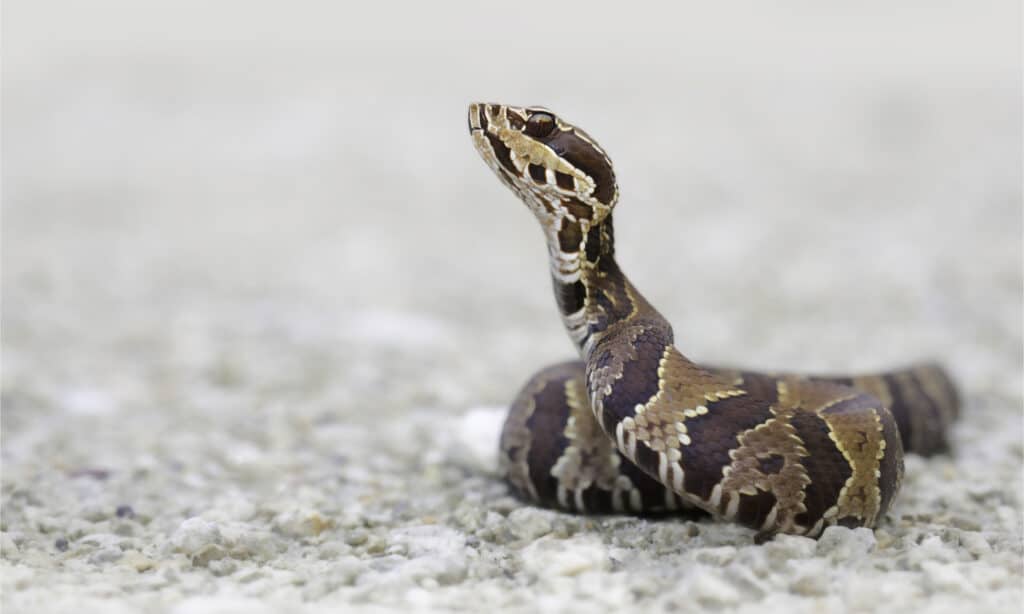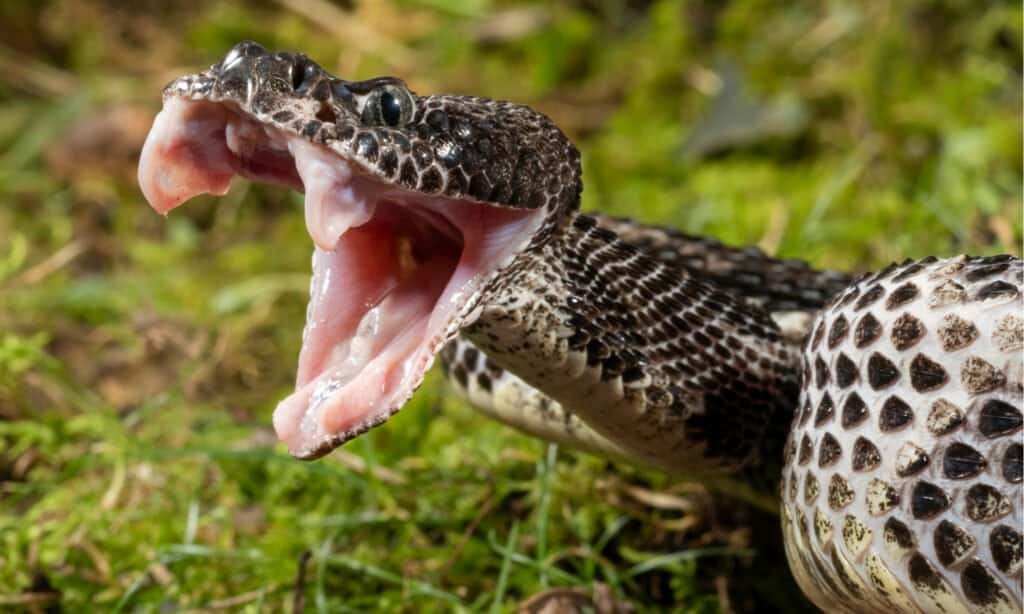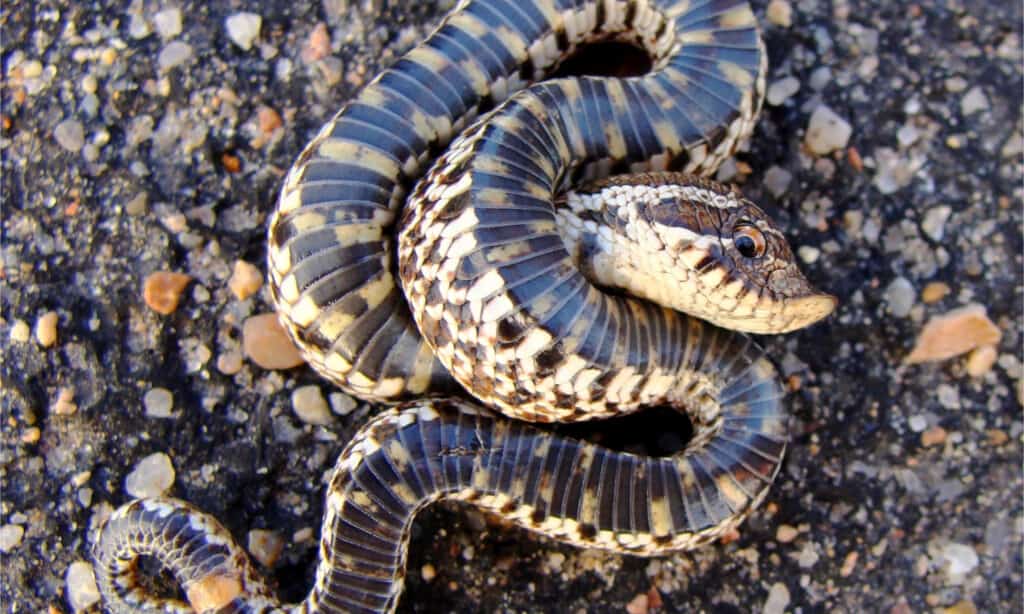Key Points:
- Water moccasins inhabit the eastern half of Oklahoma, and often occur in marshy habitats. They are the only venomous water snake in Oklahoma.
- Copperheads are not aggressive, but their bites can result in extreme pain, swelling, and severe nausea in victims. Always seek treatment if bitten by one.
- Prairie rattlesnakes rapidly vibrate their tails, producing a unique rasping sound to warn intruders. They are an aggressive species and will use about 20-55 percent of their venom in one bite.
Snakes cause great fear in many people. People often associate these slithering creatures with aggression, pain, and death. However, contrary to what you may think, most snakes are docile and will prefer not to attack except when they feel threatened or cornered. There are more harmless snakes than harmful snakes in most states in America.

Out of the over 40 species of snakes in Oklahoma, only seven are dangerous. They are venomous snake species, which include; Copperheads, Rattlesnakes, and Cottonmouths. There are five species of venomous rattlesnakes in Oklahoma, namely; timber rattlesnake, western diamondback rattlesnake, western pygmy rattlesnake, western massasauga, and prairie rattlesnake. All seven venomous snakes belong to the pit viper species, characterized by distinctive triangular-shaped heads and pit sensory organs on either side of their head. They also have retractable fangs at the top of their mouths and elliptical pupils, resembling cat eyes.
In this article, we’ll look at Oklahoma’s six largest and most dangerous snakes and how you can identify them to keep you and your family safe from them.
Oklahoma’s 6 Largest and Most Dangerous Snakes This Summer
Water Moccasins

Water moccasins can measure up to 74 inches long.
©Kristian Bell/Shutterstock.com
The only venomous species of water snake in Oklahoma, the water moccasin (also called cottonmouths) is a thick-bodied snake that typically exceeds 31 inches in total length. Some individuals have been seen to be extremely bulky, measuring about 74 inches, and weighing up to 10 lb. Common in the eastern half of Oklahoma, cottonmouths usually inhabit riparian, marshy habitats, particularly in slow-moving, shallow lakes and streams.
Water moccasins are also called cottonmouths due to the startlingly white interior of their mouth. As an adult, the cottonmouth is large and capable of delivering a painful and potentially fatal bite. Its bite has a potentially fatal venom, capable of causing necrosis of the flesh, and can lead to severe scarring and amputation. When threatened, it may respond by coiling its body and displaying its fangs. Cottonmouths are not aggressive but may bite when they feel threatened.
Copperhead

A bite from a copperhead can damage muscle and bone tissues.
©Creeping Things/Shutterstock.com
The copperhead, also known as the eastern copperhead is known for its distinctive copper-colored head and hourglass-shaped markings. Copperheads are large, heavy snakes that can grow about 3 feet long. They mostly inhabit deciduous forests and mixed woodlands, where they feed on both vertebrates and invertebrates.
In Oklahoma, there are two major subspecies of the copperhead snake. They both look the same and are equally dangerous. Though they are generally non-aggressive, copperheads are venomous snakes whose bites can result in extreme pain, swelling, and severe nausea in victims. A bite can also damage muscle and bone tissues, and eventually lead to necrosis of the flesh. Copperhead bites are a medical emergency. Immediate medical attention is key to a full recovery.
Timber Rattlesnakes

Timber rattlesnakes’ venom is one of the most potent of all venomous snakes in Oklahoma.
©Joe McDonald/Shutterstock.com
Rattlesnakes make up the largest population of venomous snakes in Oklahoma. Also called canebrake rattlesnakes, timber rattlesnakes are more common in the eastern part of Oklahoma. They are particularly fond of more wooded areas and deciduous forests with rugged terrain. During the summer, people encounter them during the twilight hours, then brumate throughout the winter season.
Identified by a pattern of dark brown or black irregular crossbands on a yellowish-brown or grayish background, timber rattlesnake adults usually grow to a total length of 36–60 inches. Their prey is mainly small mammals but may include small birds, frogs, and other snakes like the garter snake. Their venom is one of the most potent of all venomous snakes in the state, capable of injecting a lot of venom in a single bite. Fortunately, they are not aggressive and usually give many warnings before biting.
Western Diamondback Rattlesnake

Western diamondback rattlesnakes can weigh up to 15 pounds.
©Alexander Wong/Shutterstock.com
This is one of the five species of venomous rattlesnakes in Oklahoma. Western Diamondback Rattlesnakes occur in the Pineywoods region and the forested swathes of southern Oklahoma, where they have the greatest population in the Choctaw Nation and the Chickasaw Nation. Their venom is primarily hemotoxic, causing severe bleeding and other life-threatening symptoms that can be fatal.
The western diamondback rattlesnake has large venom glands and specialized glands, so it can deliver a large amount of venom in a single bite. You can easily identify this large-bodied rattlesnake by its dusty-looking gray-brown ground color overlaid dorsally with dark brown blotches. Adults commonly grow to 4 ft in length and weigh up to 3 to 6 lb. However, larger specimens measuring about 6 to 7 feet have been encountered. Very large specimens can reportedly weigh up to 15 lb —making them one of the largest species of rattlesnakes.
Prairie Rattlesnake

The prairie rattlesnake’s venom has hemotoxic, neurotoxic, and tissue destructive effects.
©Max Allen/Shutterstock.com
Generally, prairie rattlesnakes are usually lightly colored in hues of brown with patches of dark brown. A color band may be seen at the back of the eye with the presence of two internasals contacting the rostral. Distributed across the western United States, Canada, and Mexico, prairie rattlesnakes are primarily terrestrial, but occasionally climb in trees and rest in crevices or caves. They are typically active diurnally in cooler weather and nocturnally during hot weather. The venom of the prairie rattlesnake is very powerful – it has hemotoxic, neurotoxic, and tissue destructive effects. Like other rattlesnake species, prairie rattlesnakes rapidly vibrate their tails, which produces a unique rasping sound to warn intruders. They are an aggressive species and they use about 20-55 percent of their venom in one bite and will defend themselves if threatened or injured.
Western Massasauga Rattlesnake

A juvenile western massasauga rattlesnake from northern Missouri
©iStock.com/Shoemcfly
“Massasauga” is a native American word meaning “great river-mouth.” Massasaugas measure approximately 21 to 30 inches in length. Their color pattern is made up of grey or tan ground color with a row of rounded, brown/black blotches down the center of the back and along its sides. The venom of the western massasauga rattlesnake is cytotoxic, so it destroys tissue. It also contains specialized digestive enzymes that can cause severe internal bleeding. Urgent medical attention is required when bitten. However, this species is rather shy and avoids humans when it can. Most snake bites occur when people deliberately handle or accidentally step on one of these animals. Mammals and reptiles make up the bulk of their diet, as well as invertebrates such as centipedes.
Areas you might find the Massasauga are in prairie wetlands, swamps, bogs, and meadows. They have a calm disposition compared to some other rattlers, even foregoing shaking their rattle unless seriously threatened. The sound of the rattle is high pitched and doesn’t sound quite like other rattlesnakes.
Oklahoma’s 6 Largest, Most Dangerous Snakes vs Montana’s

Plains hognose snakes are one larger species found in the state of Montana.
©Matt Jeppson/Shutterstock.com
Oklahoma has snakes specific to its plains, and mid-western habitats. But other states have to deal with different large, threatening snakes. Montana not only has plains but also includes mountainous terrain due to the Rocky Mountains that run through portions of Teton, Pondera, Glacier, and Lewis and Clark counties. Interestingly, the only venomous snake in Montana is the Prairie rattlesnake, while Oklahoma is home to four subspecies of rattlesnakes. Below is a list of The Top Largest (And Most Dangerous) Snakes in Montana.
- Plains Hognose Snake
- Common Garter Snake
- Gopher Snake
- Prairie Rattlesnake
Summary of Oklahoma’s 6 Largest and Most Dangerous Snakes
Here’s a recap of 6 large and deadly snakes you should be aware of in Oklahoma:
| Rank | Snake |
|---|---|
| 1 | Water Moccasin (Cottonmouth) |
| 2 | Copperhead |
| 3 | Timer Rattlesnake |
| 4 | Western Diamondback Rattlesnake |
| 5 | Prairie Rattlesnake |
| 6 | Western Massasauga Rattlesnake |
The photo featured at the top of this post is © Joe McDonald/Shutterstock.com
Discover the "Monster" Snake 5X Bigger than an Anaconda
Every day A-Z Animals sends out some of the most incredible facts in the world from our free newsletter. Want to discover the 10 most beautiful snakes in the world, a "snake island" where you're never more than 3 feet from danger, or a "monster" snake 5X larger than an anaconda? Then sign up right now and you'll start receiving our daily newsletter absolutely free.
Thank you for reading! Have some feedback for us? Contact the AZ Animals editorial team.






